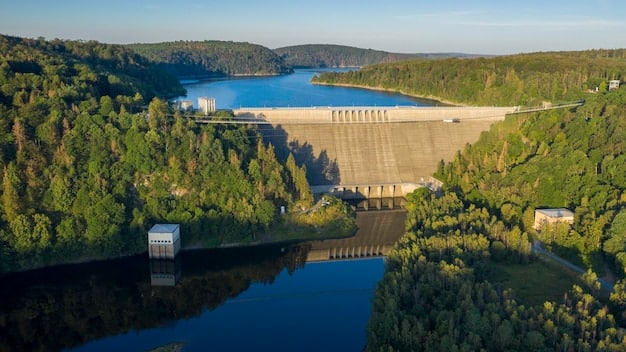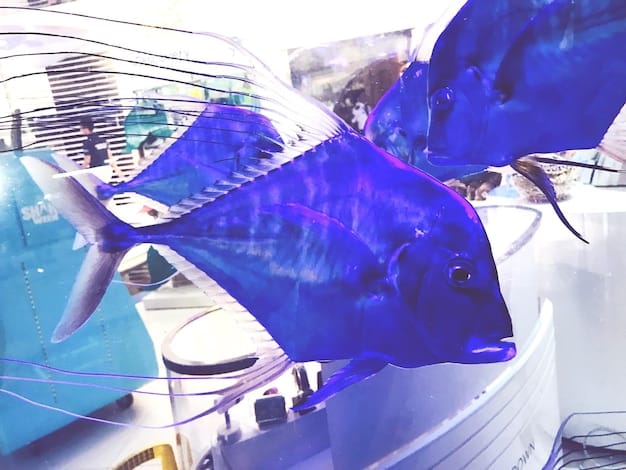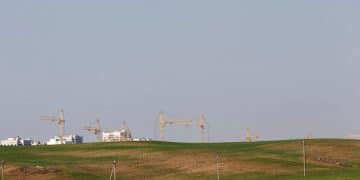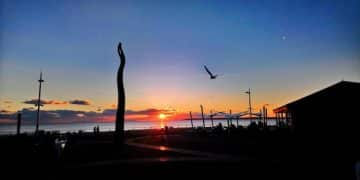Hydropower Advancements: New Technologies & Minimal Environmental Impact

Hydropower advancements are minimizing environmental impact through technological innovations like fish-friendly turbines, advanced monitoring systems, and optimized reservoir management, enhancing sustainability.
The pursuit of sustainable energy solutions has led to remarkable advancements in hydropower technology. Discover how hydropower advancements are revolutionizing the way we harness energy from water, minimizing environmental impact, and ensuring a greener future.
Understanding the Evolution of Hydropower
Hydropower, one of the oldest forms of renewable energy, has undergone a significant transformation over the centuries. From simple waterwheels to complex hydroelectric dams, the evolution of hydropower reflects our increasing understanding of its environmental impact and the drive to minimize it.
Early Hydropower Systems
Early applications of hydropower primarily involved mechanical energy, such as grinding grain and sawing wood. These systems were relatively small-scale and had localized impacts on river ecosystems.
The Era of Large Dams
The 20th century saw the rise of large-scale hydroelectric dams, designed to generate vast amounts of electricity. While these dams provided significant power, they also raised concerns about habitat destruction, altered river flows, and displacement of communities.

In recent years, hydropower technology has focused on mitigating these negative impacts. Innovations like fish-friendly turbines, improved reservoir management, and advanced monitoring systems are paving the way for more sustainable hydropower operations. These advancements aim to balance the need for renewable energy with the preservation of aquatic ecosystems.
The future of hydropower lies in harnessing the power of water in ways that are both efficient and environmentally responsible. These ongoing efforts are crucial for ensuring hydropower remains a key component of a sustainable energy mix.
Innovations in Turbine Technology
Turbine technology has been at the forefront of hydropower advancements aimed at minimizing environmental impact. Modern turbines are designed not only for efficiency but also to protect aquatic life and reduce disruption to river ecosystems.
Fish-Friendly Turbines
Traditional turbines often pose a threat to fish, particularly smaller species, which can be injured or killed as they pass through. Fish-friendly turbines are designed with wider passages and slower rotation speeds to minimize the risk of harm.
Variable Speed Turbines
These turbines can adjust their speed in response to changes in water flow, optimizing energy generation while reducing stress on the equipment. This adaptability helps maintain a more consistent output and reduces wear and tear.
- Alden Turbine: Known for its large, rounded leading edges and reduced pressure changes, significantly decreasing fish mortality rates.
- Minimum Gap Runner (MGR) Turbine: Designed with minimal spaces between the blades and the turbine housing to prevent fish from getting caught.
- Kaplan Turbine Modifications: Incorporating features like smoothed blade surfaces and reduced shear forces to enhance fish passage survival.
These innovations significantly reduce the ecological impact of hydropower plants, ensuring better safety for aquatic wildlife. By prioritizing environmental considerations, turbine technology helps hydropower facilities operate more sustainably.

Advanced Reservoir Management Techniques
Effective reservoir management is crucial for minimizing the environmental impact of hydropower operations. Modern techniques focus on maintaining ecological balance and ensuring the long-term health of river ecosystems.
Environmental Flows
Environmental flows, also known as e-flows, are regulated water releases designed to mimic natural river flow patterns. These flows support aquatic habitats, maintain water quality, and facilitate fish migration.
Sediment Management
The accumulation of sediment behind dams can disrupt ecosystems and reduce reservoir capacity. Effective sediment management strategies, such as sediment flushing and bypass systems, help maintain water quality and prevent habitat degradation.
Implementing environmental flows can help restore vital ecosystem functions, ensuring the survival of native species. Regular monitoring and adjustments are key to optimizing these flows for maximum benefit.
- Selective Withdrawal: Releasing water from different depths in the reservoir to control water temperature and oxygen levels downstream.
- Aeration Systems: Adding oxygen to the water before release to support aquatic life in the river.
- Habitat Restoration: Implementing measures to restore spawning grounds and other critical habitats affected by reservoir operations.
By adopting comprehensive strategies for reservoir management, hydropower plants can mitigate their environmental footprint and promote ecological sustainability.
Monitoring and Assessment Technologies
Advanced monitoring and assessment technologies play a vital role in understanding and addressing the environmental impacts of hydropower. These tools provide real-time data and insights that inform adaptive management strategies.
Remote Sensing
Remote sensing technologies, such as satellite imagery and drone surveys, allow for large-scale monitoring of water quality, vegetation health, and habitat changes around hydropower facilities.
Acoustic Monitoring
Acoustic tags and hydrophones are used to track fish movement and behavior, providing valuable information on the effectiveness of fish passage structures and environmental flows.
Real-time data collection enables hydropower operators to respond quickly to changing environmental conditions. This proactive approach helps prevent ecological damage and ensures sustainable operations.
These technologies provide critical information for assessing the impacts of hydropower on aquatic ecosystems.
- Water Quality Sensors: Continuous monitoring of parameters like temperature, pH, dissolved oxygen, and turbidity.
- Hydrologic Modeling: Predicting the effects of reservoir operations on downstream river flows and water availability.
- Biological Surveys: Regular assessments of fish populations, benthic invertebrates, and other aquatic organisms to track ecological health.
Through the use of these technologies, hydropower can be operated in a more ecologically sustainable manner, minimizing environmental impact.
Advancements in Dam Design and Construction
Modern dam design and construction incorporate several features aimed at reducing environmental impact. These advancements include structural modifications, innovative materials, and improved construction techniques.
Roller-Compacted Concrete (RCC) Dams
RCC dams are constructed using a dry, zero-slump concrete mix that is compacted by rollers. This method reduces the amount of cement needed, lowering the carbon footprint and minimizing the risk of thermal cracking.
Fish Ladders and Fishways
These structures are designed to help fish bypass dams and access upstream spawning grounds. Modern fish ladders incorporate features like resting pools, variable slopes, and attraction flows to improve their effectiveness.
These design improvements provide better protection for the environment.
Eco-friendly dam designs offer substantial benefits.
- Rock-Fill Dams: These dams use locally sourced rock and earth materials, reducing the need for long-distance transportation and minimizing environmental disturbance.
- Modular Dam Construction: Using pre-fabricated components accelerates the construction process, reducing the duration of environmental impact and minimizing disruptions to the surrounding area.
- Seepage Barriers: Implementing advanced sealing technologies to prevent water leakage and maintain water levels in the reservoir.
By integrating these design and construction advancements, hydropower projects can minimize their ecological footprint and promote sustainability.
Case Studies: Successful Implementation of New Technologies
Several hydropower projects around the world have successfully implemented new technologies to minimize environmental impact. These case studies provide valuable insights and demonstrate the effectiveness of innovative solutions.
The Wanapum Dam Fish Bypass Project
The Wanapum Dam on the Columbia River in Washington State implemented a state-of-the-art fish bypass system to improve fish passage survival. The project included a surface collector that guides juvenile salmon around the dam and back into the river.
The Itaipu Dam Environmental Management Program
The Itaipu Dam on the Parana River between Brazil and Paraguay has implemented a comprehensive environmental management program that includes reforestation initiatives, water quality monitoring, and fish conservation efforts.
These projects serve as models for sustainable hydropower development.
Learning from success stories is crucial for replication.
- The Safe Harbor Dam Eel Passage: This project on the Susquehanna River installed an eel passage to help American Eels migrate upstream, supporting the recovery of this important species.
- The Mayfield Dam Aeration System: This dam on the Cowlitz River in Washington State uses an aeration system to increase dissolved oxygen levels in the reservoir, improving habitat conditions for fish.
- The Three Gorges Dam Sediment Management: The Three Gorges Dam in China implemented a sediment management strategy that includes controlled releases to prevent sediment buildup and maintain downstream river health.
By studying these successful implementations, hydropower developers can gain valuable knowledge and apply proven strategies to minimize the environmental impact of their projects.
The Future of Sustainable Hydropower
The future of hydropower lies in the continued development and adoption of sustainable practices. Ongoing research and innovation are paving the way for more environmentally friendly and efficient hydropower operations.
Pumped Storage Hydropower
Pumped storage hydropower involves pumping water from a lower reservoir to an upper reservoir during periods of low electricity demand and releasing it back down to generate electricity during peak demand. This technology helps balance the grid and integrate variable renewable energy sources like solar and wind.
Small-Scale Hydropower
Small-scale hydropower projects can provide clean energy without the large-scale environmental impacts associated with traditional dams. These projects often utilize existing infrastructure, such as irrigation canals and water treatment plants, to generate electricity.
These technologies support a balanced approach to energy production.
Innovation is the key to sustainable development.
- Advanced Materials: Using new materials like composite polymers in turbine construction to reduce weight, increase efficiency, and minimize corrosion.
- Smart Grid Integration: Developing advanced control systems to optimize hydropower operations and integrate them seamlessly with smart grids.
- Community Engagement: Engaging local communities in the planning and decision-making processes to ensure that hydropower projects meet their needs and priorities.
The future of hydropower depends on a commitment to sustainability, innovation, and community engagement. By embracing these principles, hydropower can play a vital role in a clean energy future.
| Key Point | Brief Description |
|---|---|
| 🐟 Fish-Friendly Turbines | Designs reduce harm to fish during electricity generation. |
| 🌊 Reservoir Management | Techniques to maintain ecological balance in reservoirs. |
| 📡 Monitoring Tech | Advanced tools to assess environmental impacts. |
| 🌱 Dam Design | Modern eco-friendly designs reduce environmental footprint. |
Frequently Asked Questions
▼
Fish-friendly turbines are designed to minimize harm to fish passing through them, incorporating wider passages and slower rotation speeds to reduce injury and mortality.
▼
Reservoir management techniques like environmental flows and sediment control maintain ecological balance, ensuring water quality and habitat preservation for aquatic life.
▼
Hydropower facilities use remote sensing, acoustic monitoring, and water quality sensors to gather real-time data, helping them adaptively manage environmental impacts effectively.
▼
Roller-Compacted Concrete (RCC) dams are constructed with a dry concrete mix compressed by rollers, reducing cement use and the risk of thermal cracking, resulting in a lower carbon footprint.
▼
Pumped storage hydropower balances grid energy demands, integrating variable renewable sources like solar and wind, by storing energy and releasing it during peak demand periods.
Conclusion
Hydropower advancements offer promising pathways to minimize environmental impact while harnessing clean energy. By integrating innovative technologies and sustainable practices, the hydropower sector can contribute significantly to a greener and more sustainable future, balancing energy needs with ecological preservation.





